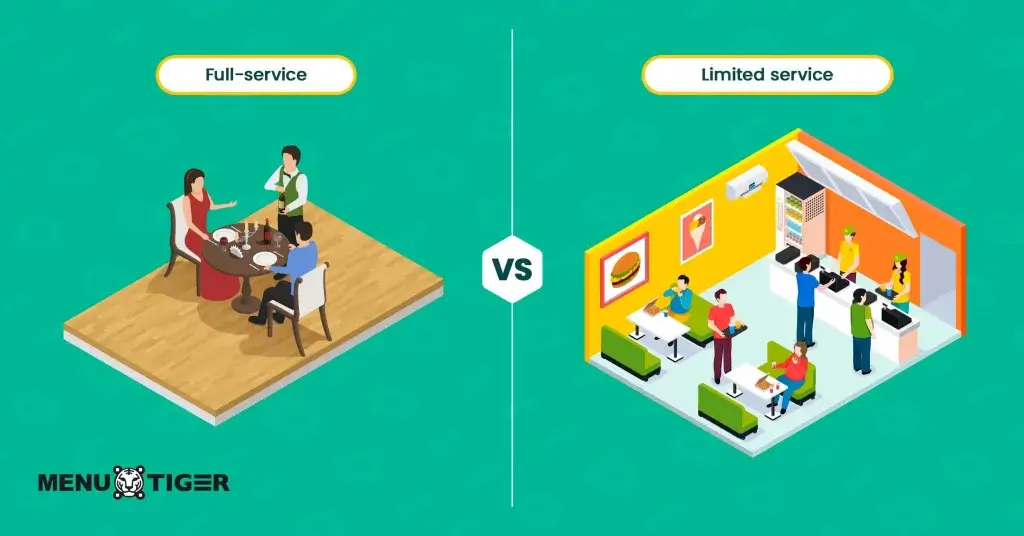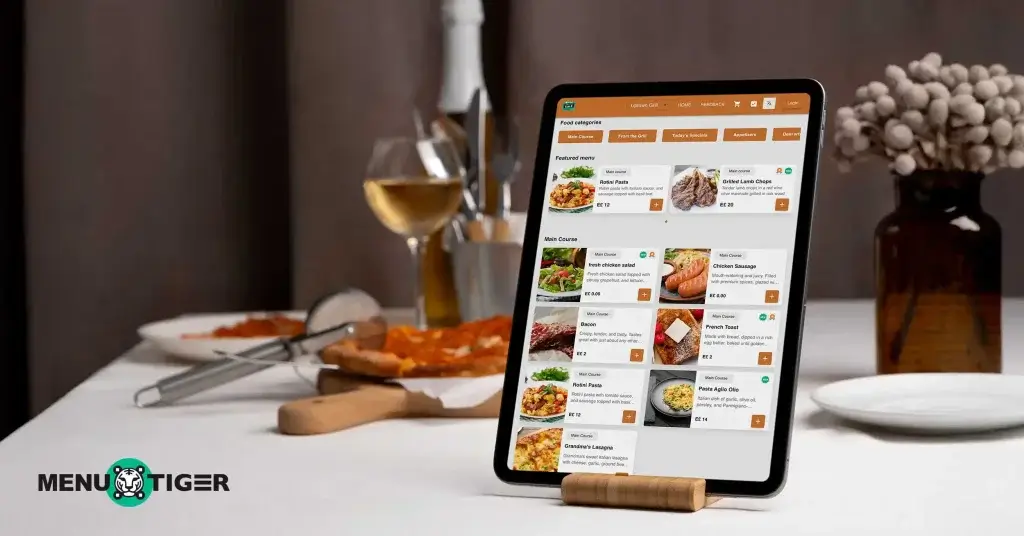
Full Service Restaurant: Overview and Industry Trends
Last Updated: November 12, 2025
One thing that makes full service restaurants stand out is how well their staff can anticipate guests' needs, often before guests even ask.
This kind of thoughtful service keeps customers happy. Reports from FSR Magazine show that full-service restaurants continue to earn some of the highest customer satisfaction ratings in the industry.
Over the past few years, full-service restaurants have changed significantly. Many are using new technology to make things easier for both guests and staff, such as digital menus, online reservations, and even delivery apps, especially since the pandemic has increased the demand for convenience.
What is a full-service restaurant?
A full-service restaurant (FSR) is a type of restaurant where waitstaff handle all aspects of service, and customers simply dine and enjoy their meal, typically what people imagine when they think of “going out to eat” or having a nice date.
At times, people simply don’t feel like cooking at home and want a relaxed dining experience where they can be taken care of.
Full-service restaurants provide exactly that, beginning with valet parking and a warm welcome from the host, followed by seating the guests at their table, taking their order, bringing the food, and attending to their needs throughout the meal until the bill is paid.
Full service vs. limited service restaurant: What’s the difference?

Full service restaurant
Full-service, as mentioned above, means customers are served throughout their entire dining experience.
Limited service restaurant
Limited service, on the other hand, refers to self-serve ordering or counter service. In this type of restaurant, the staff’s main tasks are to take orders (optional if kiosks or automated ordering systems are available), prepare food, clean, and address any issues.
Beyond that, customers are responsible for taking orders to the food counter, as it is not served to the table unless the diners are PWDs or senior citizens, and placing additional orders if needed.
Generally, this is the type of experience you get in fast-food chains, fast-casual restaurants, food courts, and cafeterias.
Types of full service restaurants
These are the different types of restaurant that offer full service:
1. Fine dining restaurants

These are the top-shelf places where you expect incredible, complex food and the highest level of full service.
Think multiple courses, beautiful plating, excellent wine lists, and staff that anticipate every need. It’s a truly special occasion destination.
2. Full service casual dining restaurants
Casual dining or fast-casual restaurants are a bit laid back compared to fine dining.
This is the go-to spot for a solid sit-down meal without the extreme price tag or formality. Guests get a dedicated server, comfy seating, and a big menu full of recognizable favorites.
It’s perfect for everyday outings with family or friends.
3. Family-style restaurants
The focus here is sharing. Food comes out on large platters meant for the whole table, which is great for groups who want to try a lot of different dishes.
You still have full table service for drinks and clearing, but the main event is passing food around.
4. Experiential dining
When we say experiential dining, the experience is the main attraction, so the service adheres to a good dining experience.
The restaurant theme, lighting, sound, and food presentation are designed to completely immerse you.
This sometimes uses wild technology or interactive elements, making the meal a memorable, sensory adventure.
5. Ethnic or specialty cuisine restaurants
These restaurants focus on authentic dishes from specific cultures or regions. They aim to deliver traditional flavors and cooking techniques, often paired with cultural decor and service styles.
This type of dining appeals to those seeking unique, culturally rich culinary experiences.

Key characteristics of full-service restaurant
Below are the key characteristics of a full service dining:
1. Exceptional service and customer experience
This is where the real difference lies. In an FSR, the experience is high-touch. The server isn't just an order-taker; they're the guide.
They'll answer detailed menu questions, offer recommendations, which often means suggesting higher-priced items, by the way, and manage the pace of every meal.
The guest is expected to sit, stay, and relax, which is why payment usually happens after you're completely done.
2. Wide variety of menu options and cuisines
Let’s compare FSRs to fast-food chains like Taco Bell or McDonald’s.
At Taco Bell, for example, you may find a variety of taco flavors, but the core offering remains tacos. Similarly, McDonald’s focuses on staple combos such as burgers, fries, chicken, and drinks.
FSRs don't do small, fixed menus. They offer diversity and depth. Think about being able to order different types of appetizers, a soup, an entrée, and a dessert—and yes, usually a nice selection of wine or craft cocktails to go with it.
The food is generally cooked-to-order from scratch (or near-scratch), which takes more time but delivers on quality and customization.
Meals are generally prepared individually for each guest rather than being mass-produced for speed.
3. Inviting atmosphere and comfortable setting

This is about creating a destination. The lighting, the music, the decor, even the type of flatware. It's all intentionally designed to set a mood that supports a longer, more enjoyable visit. Whether it's cozy casual or elegant fine dining, the setting is meant to be immersive.
They often require more physical space to accommodate dining tables, a full kitchen, bar area, and front-of-house staff stations.
4. Higher price range
Because customers are paying for that highly trained server, the skilled chef, the nicer setting, and the extra time you spend there, the price point is naturally higher.
It covers labor costs, decor and monthly maintenance for the ambiance, fresh and high-quality ingredients, and the overall experience that makes dining memorable for the customer.
5. Payment made after service
In a full-service place, guests never pay until they're totally done eating and ready to leave. No standing in line at a counter like at a fast-food joint.
The full service servers bring the bill to your table when you ask for it. It keeps that relaxed, “we're taking care of you” feeling going right until the end.
This is also when you decide on the tip for the great service you received, but it’s often more convenient to make the payment using a common digital wallet since it makes the checkout process faster, safer, and more efficient
6. Longer meal duration
A full-service meal isn't something you rush through. Since the food is made just for the customers after they order it, it takes time.
Plus, the server paces things so customers have time for starters, then your main dish, and maybe dessert.
Guests should expect to be sitting and enjoying themselves for at least 45 minutes, often much longer. It’s the opposite of grabbing a quick bite.
7. Beverage service
When you're at a full-service spot, the drinks menu is usually a big deal. It’s not just soda, you’ve got a whole range of options: wine, fancy cocktails, local beers, and specialty coffees.
The server handles everything taking your order, bringing it to you, and making sure your glass is never totally empty. It’s all part of the dedicated table service experience.
Industry outlook on future implications
Here is research from various data and market research platforms on the growth and future implications of full-service restaurants:
Growth outlook
- Business Research Insights reports that the global full-service restaurant market was valued at USD 494.02 billion in 2024 and is projected to reach USD 634.71 billion by 2033, growing at a CAGR of 3.2%.
- Future Market Insights indicates that the U.S. full-service restaurant industry is expected to grow at a CAGR of 3.5% from 2025 to 2035, driven by strong dining-out trends and increased adoption of technology in food service.
- Report and Data projects that the global full-service restaurant market will grow from USD 900 billion in 2024 to USD 1.3 trillion by 2034, at a CAGR of 3.5%.
Future implications of full-service restaurants according to Business Research Insights:
- About 63% of diners prefer restaurants offering digital or online menus and mobile payment options, boosting demand for technology-driven full-service restaurants.
- Around 44% of full-service restaurants provide takeout and delivery services, while 51% have implemented digital-only reservation systems.
- Globally, over 37% of restaurants offer online ordering, and 32% have adopted contactless payment systems.
Insights from other market research platforms:
- According to Industry research, full-service restaurants are increasingly using digital ordering, reservation systems, and AI-driven kitchen operations.
- Reports and Data show that the market is growing as restaurants adopt technology like online menus and contactless payments, improving customer convenience and satisfaction.
Technological trends in full-service restaurants
Based on future implications and current trends, here is why smart restaurant technology is a must:
Restaurant order management system

This is a menu management system that allows customers to place their orders through a QR code. At first, this trend might seem contradictory to the concept of a full-service restaurant, which emphasizes personalized service throughout the dining experience.
However, these Restaurant order management systems are not meant to replace the human touch; rather, they serve as a tool to enhance efficiency and uphold the highest standards of service.
When the pandemic hit the world, all restaurants switched to contactless ordering, and the online menu was helpful.
Today, digital ordering has become increasingly common across all types of restaurants, as research shows that many customers prefer this method.
With continued innovation, smart menus have evolved to provide even greater assistance, such as features that function like a waiter call button, enabling guests to request human service whenever needed with just one tap (which is perfect for full-service restaurants, by the way.)
Accessible and inclusive ordering
Since the Americans with Disabilities Act (ADA) was passed, restaurants have become more inclusive and accessible to people with disabilities and the elderly.
With the help of restaurant technology, such as online menus and mobile payments, and the internet of things (IoT) today, dining has become safer for individuals with strict health and safety requirements.
Digital ordering systems also help accommodate dietary needs by providing ingredient and allergen information.
In addition, accessible menus can cater to a variety of needs: for visually impaired customers, QR codes combined with screen readers provide guidance; for those who are deaf or mute, text and images ensure clear communication and an inclusive dining experience.
Online reservation system
Having an online restaurant reservation system is very important for a fine dining restaurant, as it can be quite awkward when well-dressed guests walk in and find the restaurant full with nowhere to sit.
Guests expect full service, and everything should be well-organized, uncrowded, and under control.
An online reservation system allows customers to book in advance through your website or social media platforms, making the process hassle-free.
Additionally, it benefits the restaurant by automatically updating which tables are available, helping staff manage seating efficiently and ensuring a smooth dining experience.
Delivery app and takeaway
It’s uncommon for fine dining restaurants to offer delivery and takeaway, but full-service dining has evolved to include a wide range of options, including both.
One key reason for this shift is the growing demand from office and home customers who prefer to enjoy meals in their own space but still want the quality and experience that fine dining offers.
For instance, this could include a family dinner at home or a carefully curated, elegant meal for a special date night, complete with beautifully plated dishes from your restaurant.
To start, you can opt for the cheapest food delivery app to meet this demand and remain competitive in a rapidly changing market.

Exceptional service, every time. Begin now!
So, what's the big takeaway here?
A full-service restaurant is really all about the experience. It’s where you go when you want to sit down, be waited on from start to finish, and enjoy a meal that’s cooked just for your customer, not rushed out the door.
Even though the industry is seeing huge growth, they aren't just sticking to the old ways.
We’re seeing them smartly blend that personalized service with tech, like digital menu and online reservations to make things smoother for both the customer and the staff.
FAQs
Eulla
Eulla joined MENU TIGER’s Content Team with a foundation in English teaching. She combines language expertise and creativity to produce engaging content that educates audiences and drives meaningful results.


